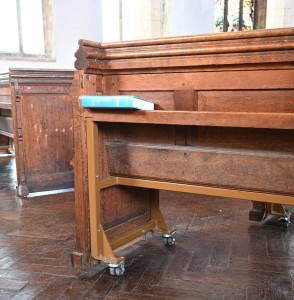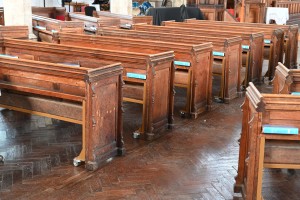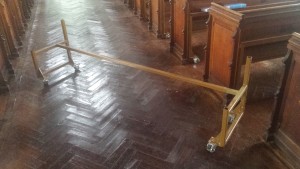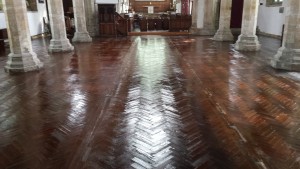From our Roving Reporter . . .
Keep on moving
By Susan Miller (February 2020)
What to do about pews? Remove them? Adapt them? Love them?
Many people including non-churchgoers really love pews. However, as many churches are also trying to use their spaces more flexibly, draw in more community groups and share their spaces, what to do with the rigid rows of heavy pews becomes a real issue.
This is about a church where the pews have become movable assets. It’s Terrington St Clement parish church in Norfolk where the Victorian pews are now on mobile metal frames.
I spoke to Stephen Young, Churchwarden and a member of the church’s Development Working Party (DWP).
What was the process behind making your pews mobile?
“A working group – about six of us – looked at creating a more flexible space. We’re talking about 2014 but the process actually started in 2010.
Helen Slipper, the vicar’s wife had been doing some research and came along with photographs and stories about what a few other churches had done -– in this case in London – and we thought how could we apply this at St Clements?
There was a church in London… they had substantial oak pews and they’d fitted casters to them. Our pews were not so malleable so we looked for an alternative.
We started off by trying to put a wooden frame underneath the pew to attach the casters but that looked ugly so as we have an engineering company in the village (AJ Hodgson and Sons), we gave them a pew and said can you come up with a solution?
They produced a metal frame which we tweaked a little bit. Once we got the prototype, we asked can you make us 35 frames? And they could. We also powder-coated the frame so it wouldn’t need to be repainted. And it really blended in with the oak pew. When you walk into the church you wouldn’t even know they were on wheels. The idea went very smoothly.
We appealed to the village for help fitting the frames and about 20 volunteers turned up one Saturday morning to help. So, 35 pews were converted in a couple of hours.”
Was that your first idea?
“We’d started off with the idea of taking the pews out and putting wooden chairs in. But we couldn’t agree on a chair that was acceptable to the Diocese and to us and also the cost was soaring, it was something like £22k-£23.
Also, there’s a lot of passion about pews, people love their pews.”
What is it about pews that people love?
“I think it’s a traditional view of church that you walk in and there are nice, neat rows of pews facing forward. The fact that it is a Victorian addition doesn’t seem to make much difference. This church is something like 700 years old and the pews have only been there a hundred years … but people have a traditional view of what a church can look like. Pews are a big part of that. However, they’re not the most comfortable form of seating.”
How did the Diocese react?
“We initially applied to the DAC for advice, they were happy with the proposal and allowed us to proceed to full faculty with the Chancellor.
There wasn’t any opposition to the idea of the casters on the pews. The main opposition was when we were thinking about pews out, chairs in. The Diocese weren’t keen on that and a lot of the locals weren’t keen on losing their pews.”
What was the process?
“The DAC consulted with the Victorian Society and the council for the care of churches (Church Buildings Council) and they were both happy to leave the decision with the DAC. We also consulted Historic England and they had no objection.”
And the reactions?
“Hugh McCurdy, our archdeacon, brought the DAC up here after we had finished the project and they were quite enamoured of it. Norwich Diocese, Cambridge, we’ve had quite a lot of interest from churches who’ve come to photograph it and gone away and looked at seeing if they can apply it to their buildings.”
What difference has it made to the church?
“It’s given us a much more flexible space. We’re a very large church. We’ve got the largest length from east to west in Norfolk. Locally it’s known as the Cathedral of the Marshes. We had a massive, massive space inside but everything was fixed to the floor. So, it was how can we be more flexible and do different things? That was a driving force. We had two side aisles with pews in and you couldn’t get a good view because of the columns but now they’re flexible we can actually get three rows of pews in the middle of the church.”
What do you use the church for?
“During the school holidays we ran a Rock Café, we had about 30 plus children and their parents for the five weeks holiday and we were able to turn the pews around, use tables and have craft activities. Obviously, there was some Christian content there and that proved very popular. We’re a vibrant church, we have an electoral roll of over 90. The average attendance is around the 60/65 mark and two youth groups meet during the week- in the church. Using it a lot is really important.”
Back to main Roving Reporter page




